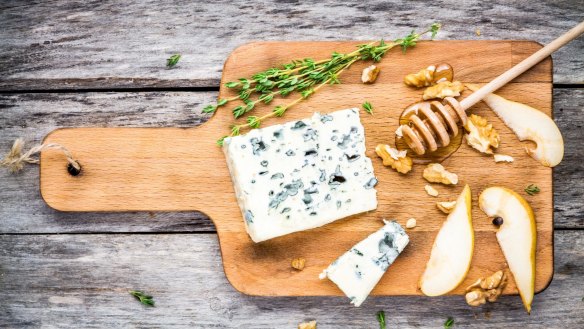What's the best thing to serve with cheese?

What is the best thing to serve with cheese? L. McClelland
More cheese. Seriously. Cheese gets lonely on a wooden board. For a great all-Australian line-up, start with a soft white mould cheese such as Bloomy from Pecora Dairy, move on to a washed-rind cheese like Mont Rouge from Section 28, and a blue such as Shadows of Blue from Tarago River and finish with a hard cheese, perhaps a Bruny Island Raw Milk C2.
Crusty bread is good but avoid loading the board up with dried fruit. Some modern cheese boards are so laden with dried pears and apricots it looks like a couple of Sunbeam and Angas Park delivery trucks have collided on the table.
Crusty white bread is good with soft cheeses, and blue cheese loves quince paste or even honeycomb. (Try mixing the honeycomb through the blue cheese – the amino acids in the honey add to the deliciousness of the cheese.)
Speaking of amino acids, try serving cheese with sourdough crackers. I first encountered them when I co-wrote Phillippa's Home Baking, and re-discovered them during the great COVID-19 lockdown of 2020 when I, like most imprisoned bread lovers, made sourdough at home.
You can make the crackers by mixing 230g of your sourdough starter with 100g of baking flour and 4g of salt. Shape the dough into a ball and place in a bowl, cover with a plastic bag and leave in a warm place for 1 hour. Divide the dough into six equal-sized balls and roll out each on a strip of floured baking paper to a 1.5mm thick tongue. Allow to shrink. Roll out once more. Lift onto a baking tray, refrigerate for 30 minutes. Preheat the oven to 220C fan-forced (250C conventional). Spray with a little water, sprinkle with sea salt and bake for 25 minutes or until deep gold. Allow to cool.
All those dead yeast cells in the sourdough are full of amino acids and create their own umami, that sensation of deliciousness. This primes the taste buds for the cheese, which has its own amino acids and deliciousness. These different amino acids have a synergistic effect, meaning that together they create a deliciousness greater than the sum of their parts.
Why do waiters in restaurants fuss about with water as soon as you sit down? Sometimes I just want to order my food! B. Sefton
From the moment you walk through the door of a restaurant to the moment you step back onto the footpath, you are part of an invisible theatrical production running to a hidden script, written by the restaurateur, called the "sequence of service".
The story goes like this. In a well-run restaurant, you're greeted and seated, and then water is poured into your glass. This is a lovely piece of old-fashioned hospitality – you may have travelled some way and have a thirst. It also signals to the staff in the room that you're ready for menus. Menus should be passed from the right, opened on the first page. Beverages are served first and then the bread and butter placed on the table.
In a three-hat restaurant the sequence of service may have 75 small instructions that describe how every point of contact between the wait staff, the customer, and the kitchen is made, from whom gets asked their order first to when the crumbs are cleared from the table.
More casual eateries may have between 25 to 50 instructions. While this seems very mechanical, it is the skill of good wait staff that makes the process seem seamless and effortless. This is where training, experience, hospitality culture and performance converge and why dining out can be such a joy.
Send your vexing culinary conundrums to brainfood@richardcornish.com.au or tweet to @foodcornish
Appears in these collections
- More:
- Food
- Brain food
